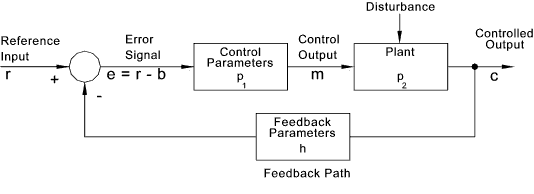Introduction
Control systems are in essence systems for controlling
other systems.
There are two general classifications of Control Systems.
- Open Loop System for which the control action is independent of the output.
- Closed Loop System for which the control action is dependent, in some
way, on the output.
|
Closed loop systems are also called feedback systems. They are often complicated to analyse requiring differential calculus.
Open loop systems have two important features....:
1) They depend on their calibration for accurate operation.
2) They are not normally affected by stability problems. There is very little risk that an input
will result in an unexpected output result.
The concept of feedback is the important feature that distinguishes closed loop systems from
open loop systems. The systems that produce the feedback, the methods of comparing the feedback with
the desired (input) variables and the actions resulting from the comparisons are the basis of closed
loop control systems...
Most control systems used by man are basic manual control system e.g. opening a tap to fill a tank with water
and then closing the tap. This basic system includes a number of parameters.
- The input requirement - Filling the tank to a set waterlevel
- The feedback signal - Viewing the level of water in the tank
- Signal comparison - Comparing the tank water level with the required level
- Control Output - Decision to open /close filling valve
- Plant operation - Opening /closing the filling valve
- Output - Level of water in tank
|
This control system is typical of most engineered control systems. In practice there is
no economic basis to provide an engineered system for this duty. However are many control requirements
which are done more economically by computers and machines and the notes below relate to these systems.
A typical control system is illustrated by the following diagram..

The control system notes below relate to linear control systems in which the relationships
can be described with linear differential equations with constant coefficients. In the real
world systems generally include non-linearities e.g slip-stick ,non constant delays, hysteresis effects.
These are difficult to analyse and the overall system performance can often be closely approximated by
using linear techniques...
Control System Definitions
- System...A system is an arrangement or collection of entities such that
they form and act as a single unit.
- Control System...A control system is an arrangement of physical components connected
or related in such a manner as to command, direct, or regulate itself or another system
- Input...A stimulus or excitation applied to a control system from an external energy source to
produce a specified response from the control system
- Output ... The output is the actual response obtained from the control system. It may
or may not be equal to the response implied by the input.
- Open loop ... An open loop control system is one in which the control action
is independent of the output.
- Closed loop ... A closed loop control system is one in which the control action
is related to the output.
- Feedback ... Feedback is that property of a closed loop system which permits the output ( or
some other controlled variable of the system ) to be compared with the
input to the system ( or an input to another part of the system) so that
the appropriate control action may be completed as some function of the input
and output
- Servomechanism ... A power -amplifying feedback control system in
which the controlled variable is mechanical position, or a time derivative
of position such as velocity or acceleration. The primary purpose is to cause the controlled
output to follow variable input. e.g. a plane guidance system
- Regulator ... A feedback control system in which the reference input
is fixed over the operating time period. The primary purpose of a regulator
is to maintain a constant output
|
Feedback characteristics
Including feedback into the control of a system results in the following advantages:
- Increased accuracy . The output can be made to reproduce the input
- Reduced sensitivity to system characteristics
- Reduction in effect of non-linearities
- Increased bandwidth. The system can be made to respond to a larger range of
input frequencies
The major disadvantages resulting from feedback are the increase risk of
instability and the additional cost of design
and implementation..
|
Control Models
In the study of control systems the systems are generally modelled using
- Differential equations and other mathematical devices
- Block Diagrams
- Signal Flow Diagrams
|
Block diagrams and signal flow paths are shorthand graphical representations
of either the schematic representation of the physical system or the set
of mathematical equations characterising the component parts of the system.
The block diagram generally includes the following elements...
The Block
Symbol usually contains a description or name of the element
or the symbol for the mathematical operation to be performed. The arrows
represent direction of information or signal..

The Summing Point
This has appropriate arrows representing flow of information or signals and a + or - to indicate
if sign of the operations to be performed on the signals."" The summing point generally has two
or more inputs and one output to which the sum of the inputs is routed.

The Take-off point.
In order to route the same variable to a number of blocks or summing points
a take-off is used as shown below..

A generalised feedback control system based on the above symbols is shown below

|




